Quito
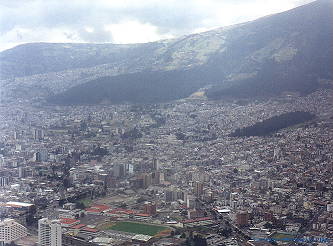
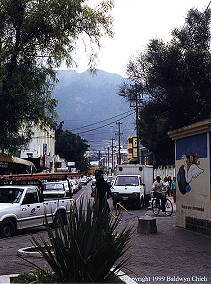
Don't let the man with the gun scare you. Armed guards stand
at every bank, jewellry store, or money exchange place
|
We arrive late on September 1, 1999 to the capital city of Ecuador, Quito.
The airport is small by American standards, but quite efficient. As we
walk out the exit, people are pressed up against the gate offering taxi
rides, or waving signs. We spot our guides Roberto and Carlos, and they
introduce us to the city on the way to the Hotel Sebastian. The weather is
cool and crisp, requiring jackets at night, and the cultural dress code of
the city of long pants was not at all uncomfortable. The weather in Quito
is described as "The Eternal Spring", and that's exactly how it felt. Quite
a surprise considering that we were only 22 kilometers from the equator!
Quito is often the springboard city for travellers to the Galapagos.
Indeed, our thoughts were that it would be a transitional city, as
we passed through for our adventures elsewhere. But in the end, it
felt more like we were returning home, even though we spent less than
three days there. Often referred to as the nicest city in South
America, there is definately something about Quito that makes one
think of returning again someday.
|
The Andes provide the spectacular backdrop to this city, flanked by
mountains and volcanoes on both sides. On a clear day, you can see
the peak of Cotapaxi, rising up in a perfect, snow-covered cone.
Less than twenty miles to the northeast, we could see Pichincha expelling
steam, and later sulphur and ash, putting the area into an "orange alert"
with it's volcanic activity. Word on the street is that it's getting ready
to erupt for a spectacular New Year's celebration.
The downtown area along Amazonas Avenue alternates between brand new
shops that you might see along a trendy US street, to older, family
run businesses. Street vendors are everywhere, selling lottery tickets
and magazines, fried banana chips, sweaters and jewellry. Indian children
are bound to try to sell you candy, roses, or even shampoo.
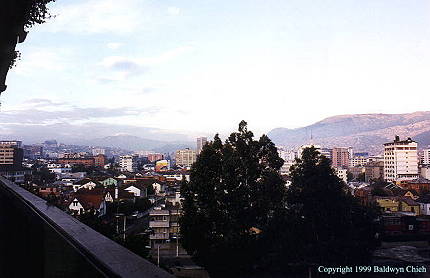
My 6th floor balcony view at Hotel Sebastian
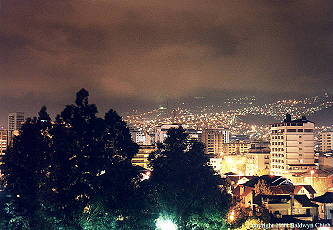
Sixth floor view again at night
|
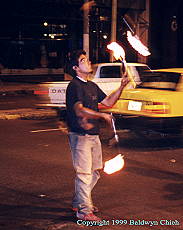
Juggler works for change in the street between green lights
|
Traffic was interesting in the city. Cars dart and weave, never using
turn signals, but beeping your horn to warn of your approach is standard.
Lane markings were a guide, not a rule. The thickness of exhaust in the
air reminded me never to complain about having my car smogged in California.
|
The restaurants in the city provided us wonderful dining experiences.
We spent a couple of hours at Cafe Amazonas, ordering a quart of pilsener
for a dollar seventy, and eating ceviches; marinated seafood (generally),
served with popcorn, and let the city walk past us. La Terraza Del Tartaro
was a perfect spot after returning from the Galapagos, as the night
was on the chilly side. A crackling fire, tasteful decor and a
twelve floor view over Quito made it seem like we were in the most
expensive restaurant in town, but our bottle of wine, ceviches,
steak and lobster tallied up to less than $35. We had our farewell dinner
at La Ronda, named after the colonial era street that's boasted as one of
the most beautiful in Quito.
|

Hallway entrance to La Ronda
|
So many of attractions of Quito were left unseen this trip. The Monastery
of San Francisco, La Ronda in Old Town, El Mitad Del Mundo, a monument that
marks the equator line, are all recommended. Regional sites include
Otavalo and of course the many volcanoes along The Avenue Of Volcanoes
(also known as the Pan-American Highway). Maybe next time!
Next |
Home




